To be a real Moroccan chef, one needs to embrace the essence of the cuisine, which is all about layering flavors and using fresh, seasonal ingredients. It’s not just about the spices like cumin and saffron; it’s also about the storytelling that happens when meals are prepared in a tajine. Engaging with local markets and understanding the cultural significance of each dish can transform a cook into a true culinary artist. But what’s the secret ingredient that makes Moroccan meals so memorable? That’s where the journey really begins.
Good To Know
- Master traditional cooking techniques like tajine preparation and couscous steaming to create authentic Moroccan dishes.
- Utilize essential spices such as cumin, coriander, and saffron to enhance flavors and depth in your cooking.
- Prioritize the use of fresh, seasonal ingredients from local markets to ensure quality and authenticity in your meals.
- Embrace the cultural significance of Moroccan meals by understanding their communal nature and the stories behind each dish.
- Develop your culinary skills through hands-on experiences with local chefs, enhancing both techniques and cultural knowledge.
Understanding Moroccan Cuisine
Moroccan cuisine is a vibrant tapestry of flavors, ingredients, and cooking techniques that reflect the country’s rich history and diverse cultural influences.
It’s a delightful blend of Berber, Arab, and Mediterranean traditions, showcasing the unique culinary artistry of its people. The meals often revolve around communal dishes, with tajines and couscous taking center stage. Each dish tells a story, whether it’s a celebration, family gathering, or everyday meal.
Cooking techniques vary, from slow-cooked stews to grilled meats, ensuring each bite bursts with flavor. On top of that, the importance of hospitality shines through, as meals are often accompanied by traditional mint tea, symbolizing warmth and welcome.
Embracing Moroccan cuisine means embracing a culture deeply rooted in community and shared experiences.
You can also read our reviews of more tours and experiences in Essaouira.
Essential Ingredients and Spices
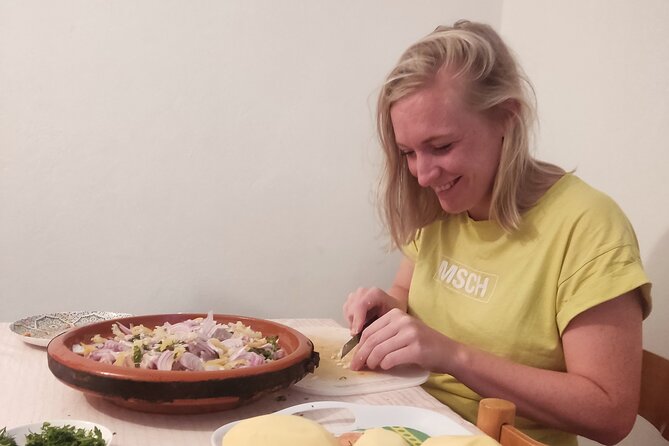
What makes Moroccan dishes so distinct and flavorful? It’s all about the essential ingredients and spices that bring these meals to life.
A Moroccan chef often leans on staples like cumin, coriander, and paprika, each adding depth and warmth. Saffron, though pricey, lends a luxurious touch to dishes, while cinnamon introduces a sweet undertone that surprises the palate.
Fresh herbs, especially cilantro and parsley, brighten flavors, giving a vibrant finish. Don’t forget about preserved lemons—they’re key for that tangy kick.
For proteins, lamb, chicken, and fish shine in tajines, but vegetarian options, like chickpeas, are just as delicious.
Mastering these ingredients allows any aspiring chef to create authentic Moroccan cuisine that truly captivates the senses.
Mastering the Tajine Technique

Creating authentic Moroccan dishes goes beyond just knowing the ingredients; it’s about mastering the techniques that bring them together, with the tajine being a centerpiece of this culinary art.
To truly excel in cooking with a tajine, one must focus on these key aspects:
-
Layering Flavors: Start with a base of aromatics like onions and garlic, then layer in spices, followed by proteins and vegetables. This method creates a depth of flavor.
-
Temperature Control: A tajine cooks slowly, so maintaining a low, steady heat ensures everything cooks evenly without burning.
-
Moisture Management: The conical lid traps steam, allowing the dish to self-baste. It’s crucial to check for moisture levels, adding liquid as needed to prevent dryness.
Mastering these techniques makes anyone a true Moroccan chef.
The Importance of Freshness
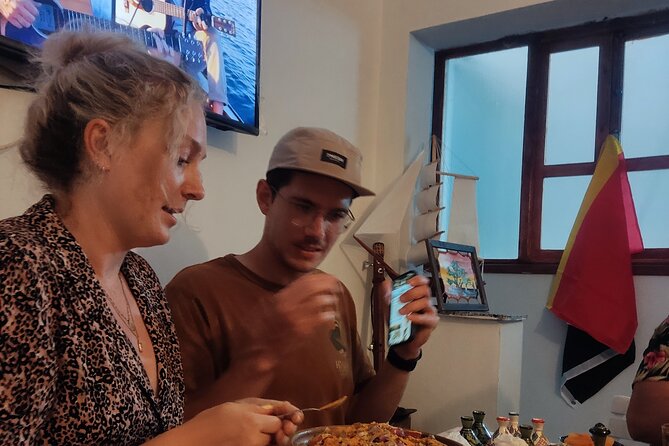
Fresh ingredients are the backbone of authentic Moroccan cuisine, elevating every dish to new heights. Using seasonal produce and high-quality meats makes a significant difference in flavor and texture. When cooking Moroccan dishes, freshness isn’t just a preference; it’s a necessity.
| Fresh Ingredient | Key Benefit |
|---|---|
| Seasonal Vegetables | Enhanced flavor profile |
| Locally Sourced Meat | Superior tenderness |
| Fresh Herbs | Aromatic richness |
Chefs know that fresh herbs like cilantro and parsley add a vibrant touch, while seasonal vegetables bring color and variety. Emphasizing freshness not only honors traditional recipes but also supports local farmers and markets, creating a sustainable culinary practice. This commitment to quality ingredients is what truly defines a Moroccan chef.
Cooking With Local Chefs
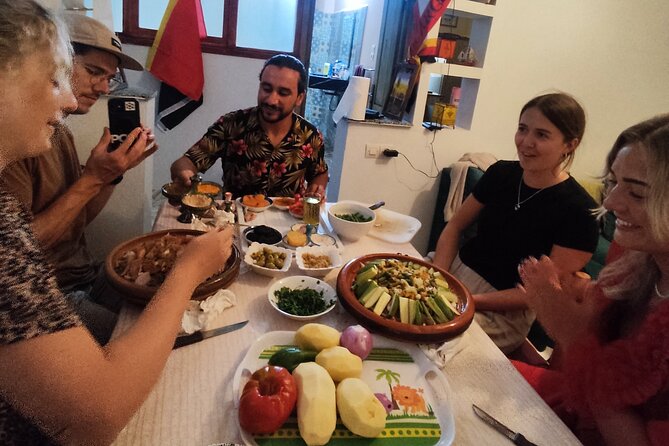
Cooking with local chefs offers a unique opportunity to dive into the heart of Moroccan culinary traditions.
These experiences connect aspiring chefs with the rich flavors and techniques that define Moroccan cuisine. Participants not only learn to prepare traditional dishes but also gain valuable insights into local culture.
Here are three key aspects of cooking with local chefs:
-
Ingredient Sourcing: Begin the journey at local markets, selecting fresh produce and spices, enhancing the authenticity of each dish.
-
Hands-On Cooking: Work side by side with experienced chefs, mastering the art of tajine and other classic recipes.
-
Cultural Exchange: Engage in conversations that reveal the stories and customs behind each meal, turning cooking into a shared experience.
This immersion creates lasting memories and skills.
Cultural Context of Moroccan Cooking
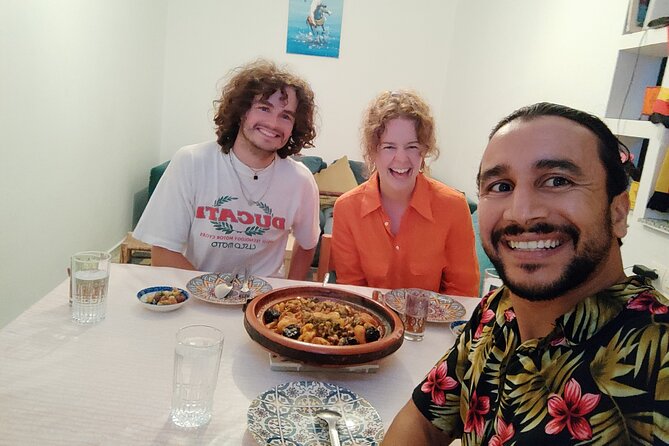
Moroccan cooking is steeped in a rich cultural heritage that reflects the country’s diverse history and influences. Traditions blend Berber, Arab, and Mediterranean flavors, creating a culinary tapestry that tells a story. The essence of Moroccan cuisine lies in the communal experience, where meals become a celebration of togetherness.
| Element | Description |
|---|---|
| Spices | Essential for depth and flavor |
| Cooking Methods | Tajine and couscous steaming |
| Meal Structure | Starter, main, and dessert |
Every dish carries a narrative, with each ingredient meticulously chosen for its significance. This cultural context not only enriches the palate but also fosters connections among family and friends, making Moroccan cooking a heartfelt art form.
Exploring Dietary Accommodations

When it comes to dietary accommodations, this cooking course embraces inclusivity by catering to various preferences and restrictions.
The local chef understands that everyone has unique needs and is committed to ensuring a delightful experience. Guests can easily communicate their dietary requirements, and the chef will customize the menu accordingly.
Here are some common accommodations offered:
-
Vegetarian Options: Guests can enjoy a delicious vegetarian tajine, packed with fresh vegetables and aromatic spices.
-
Gluten-Free Choices: The chef can prepare gluten-free dishes, ensuring everyone can savor the flavors of Moroccan cuisine.
-
Halal Ingredients: All meats provided are halal, making it suitable for Muslim participants.
Enhancing Your Cooking Experience
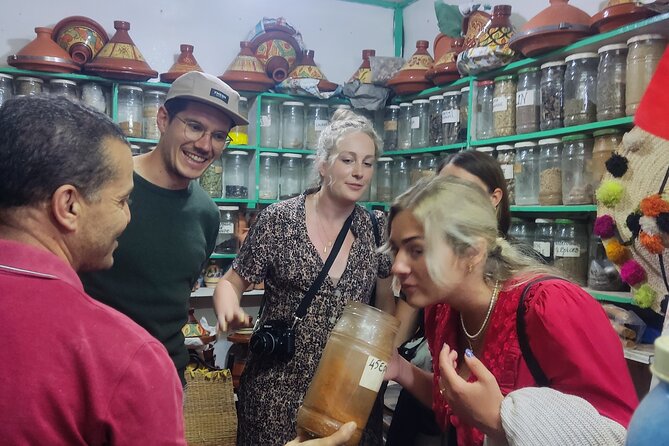
There are several ways to enhance the cooking experience during this Moroccan culinary adventure. Engaging all senses makes cooking memorable. Here’s a quick guide to maximize enjoyment:
| Tip | Description |
|---|---|
| Market Visit | Immerse in local culture by selecting fresh ingredients. |
| Cooking Together | Foster camaraderie while preparing traditional dishes. |
| Learn Traditions | Understand the history behind each dish as you cook. |
| Mint Tea Ritual | Experience the art of making Moroccan mint tea. |
Frequently Asked Questions
What Traditional Utensils Are Essential for Moroccan Cooking?
In Moroccan cooking, essential utensils include a tagine for slow cooking, a mortar and pestle for spices, and a couscoussier for steaming couscous. These tools enhance flavors and showcase the vibrant culinary traditions of Morocco.
How Can I Incorporate Moroccan Flavors Into Non-Moroccan Dishes?
To incorporate Moroccan flavors, she suggests using spices like cumin and coriander, adding preserved lemons, and experimenting with harissa. Mixing these elements into familiar dishes can create delightful, unexpected culinary experiences that tantalize the palate.
What Are Common Mistakes to Avoid When Cooking Moroccan Food?
When cooking Moroccan food, he advises avoiding overcooking spices, neglecting fresh ingredients, and skipping the key step of tasting throughout. Mastering these elements ensures authentic flavors and a delightful dining experience that truly embodies Moroccan cuisine.
How Do I Properly Store Moroccan Spices for Longevity?
He recommends storing Moroccan spices in airtight containers, away from light and moisture. Keeping them in a cool, dark place helps maintain their flavors, ensuring they last longer and enhance dishes beautifully when cooking.
What Is the Significance of Moroccan Mint Tea in the Culture?
Moroccan mint tea symbolizes hospitality and friendship. It’s often served during gatherings, reflecting cultural values. Locals cherish its refreshing taste, while the ritual of pouring showcases artistry, making it a beloved tradition in Moroccan society.
The Sum Up
Becoming a real Moroccan chef isn’t just about perfecting recipes; it’s about embracing the culture, community, and flavors that define Moroccan cuisine. By mastering essential spices, honing the tajine technique, and prioritizing fresh, local ingredients, anyone can elevate their cooking. Engaging with local chefs and understanding the cultural significance of meals adds depth to the culinary journey. Ultimately, sharing food with loved ones embodies the heart of Moroccan hospitality, making every dish a celebration of togetherness.
More Tour Reviews in Essaouira
Not for you? Here's more nearby things to do in Essaouira we have reviewed
- Quad Ride in Essaouira via Forests Dune & Beach
- Essaouira City Day Trip From Marrakech
- Essaouira Day Trip From Marrakesh
- From Marrakech : Private 1-Day Trip To Essaouira Mogador
- 3-Hours Dromedary Ride Essaouira, Morocco
- From Essaouira: Private Transfer to Casablanca
- 1/2 Day Camel Trekking in Essaouira With Meals
- A Day Trip to Essaouira – the Beach
- Marrakech : Private Transfer From or to Marrakech Airoport
- From Marrakech: Essaouira Day Trip With Hotel Pickup
- Combined Trip: 3 Days Atlas and 3 Days Essaouira
- From Marrakech: Essaouira Private Full-Day Trip
